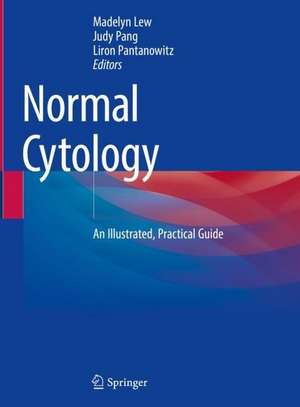Normal Cytology: An Illustrated, Practical Guide
Editat de Madelyn Lew, Judy Pang, Liron Pantanowitzen Limba Engleză Hardback – 2 ian 2023
In the practice of cytopathology, cytologists frequently encounter a spectrum of benign, normal cells in samples. In fact, these normal cells frequently comprise the greatest proportion of material present on a cytology slide. This is frequently the case in Pap smears of the uterine cervix , urine samples, and lung samples such as bronchial brushings. Normal cytology can often mimic pathology leading to misdiagnoses, especially in cases with reactive and metaplastic changes. Moreover, cytopathology findings of certain neoplasms can also mimic normal cytology.
Today, cytology laboratories are no longer confined to dealing with just exfoliative specimens and superficial aspirations. With interventional radiology as well as endobronchial and endoscopic ultrasound-guided fine needle aspirations (FNA), we increasingly encounter visceral samples. Hence, cytologists are even likely to encounter normal elements from deep-seated organs. Sometimes, unexpected normalelements may be found within cytology specimens because a FNA procedure has contamination or inadvertently sampled a nearby organ or normal anatomical structure. A typical example is the finding of ganglion cells when a FNA is performed targeting a celiac node for cancer staging (Elgarby EA et al. Frequency and characterization of celiac ganglia diagnosed on fine-needle aspiration. Cytojournal. 2015; 12:4).
Despite the importance of knowing the spectrum of normal cytology, there are limited reference materials available on this topic for cytologists. Most cytopathology texts deal with abnormal cytology. Often, the chapters in these books only devote a few sentences about normal cytology (euplasia). Our proposed book intends to fulfil this need. The book will contain a mixture of text and images (atlas). Important aspects related to cytology practice will be highlighted such as clinical relevance, differential diagnoses, mimics and pitfalls. The images will include a variety of cytology specimen preparations (e.g. direct smears, liquid based samples, touch preparations, cell blocks) and stains (e.g. Diff Quik/MGG, Papanicolaou, H&E). In selected cases, the expected immunoprofile of normal cells will be addressed. Each chapter will also include a modest list of helpful and contemporary references.
| Toate formatele și edițiile | Preț | Express |
|---|---|---|
| Paperback (1) | 752.39 lei 38-44 zile | |
| Springer International Publishing – 3 ian 2024 | 752.39 lei 38-44 zile | |
| Hardback (1) | 983.00 lei 38-44 zile | |
| Springer International Publishing – 2 ian 2023 | 983.00 lei 38-44 zile |
Preț: 983.00 lei
Preț vechi: 1034.73 lei
-5% Nou
Puncte Express: 1475
Preț estimativ în valută:
188.09€ • 196.91$ • 155.64£
188.09€ • 196.91$ • 155.64£
Carte tipărită la comandă
Livrare economică 01-07 aprilie
Preluare comenzi: 021 569.72.76
Specificații
ISBN-13: 9783031203350
ISBN-10: 3031203356
Pagini: 174
Ilustrații: XIII, 174 p. 260 illus. in color.
Dimensiuni: 210 x 279 mm
Greutate: 0.78 kg
Ediția:1st ed. 2022
Editura: Springer International Publishing
Colecția Springer
Locul publicării:Cham, Switzerland
ISBN-10: 3031203356
Pagini: 174
Ilustrații: XIII, 174 p. 260 illus. in color.
Dimensiuni: 210 x 279 mm
Greutate: 0.78 kg
Ediția:1st ed. 2022
Editura: Springer International Publishing
Colecția Springer
Locul publicării:Cham, Switzerland
Cuprins
Introduction.- Respiratory System.- Digestive tract (oral cavity, esophagus, stomach, intestines, and anus).- The Hepatobiliary System.- Exocrine Glands.- The Endocrine Glands.- Lymphoid & hematopoietic systems (nodes, thymus, spleen, bone marrow).- The Urinary Tract.- Female Reproductive System.- Male Reproductive System (prostate, seminal vesicle, and testis).- Breast.- Musculoskeletal System (bone, cartilage, muscle, soft tissue) and Skin.- Body Cavities (mesothelium, synovium).- Central Nervous System, Peripheral Nervous System, and Eye.
Notă biografică
Madelyn Lew, MD
Michigan Medicine Department of Pathology
2800 Plymouth Rd, Bldg 35
Ann Arbor, MI 48109
Tel: (734)936-6622
Judy C. Pang, MD
Michigan Medicine Department of Pathology
2800 Plymouth Rd, Bldg 35
Ann Arbor, MI 48109
Tel: 734-232-0251
Liron Pantanowitz, MD PhD MHA
Michigan Medicine Department of Pathology
2800 Plymouth Rd, Bldg 35
Ann Arbor, MI 48109
Tel: 413-237-4397
Textul de pe ultima copertă
In the practice of cytopathology, cytologists frequently encounter a spectrum of benign, normal cells in samples. In fact, these normal cells frequently comprise the greatest proportion of material present on a cytology slide. This is frequently the case in Pap smears of the uterine cervix , urine samples, and lung samples such as bronchial brushings. Normal cytology can often mimic pathology leading to misdiagnoses, especially in cases with reactive and metaplastic changes. Moreover, cytopathology findings of certain neoplasms can also mimic normal cytology.
Today, cytology laboratories are no longer confined to dealing with just exfoliative specimens and superficial aspirations. With interventional radiology as well as endobronchial and endoscopic ultrasound-guided fine needle aspirations (FNA), we increasingly encounter visceral samples. Hence, cytologists are even likely to encounter normal elements from deep-seated organs. Sometimes, unexpected normal elements may be found within cytology specimens because a FNA procedure has contamination or inadvertently sampled a nearby organ or normal anatomical structure.
Despite the importance of knowing the spectrum of normal cytology, there are limited reference materials available on this topic for cytologists. Most cytopathology texts deal with abnormal cytology. Often, the chapters in these books only devote a few sentences about normal cytology (euplasia). This book intends to fulfil this need. The book contains a mixture of text and images. Important aspects related to cytology practice are highlighted such as clinical relevance, differential diagnoses, mimics and pitfalls. The images include a variety of cytology specimen preparations (e.g. direct smears, liquid based samples, touch preparations, cell blocks) and stains (e.g. Diff Quik/MGG, Papanicolaou, H&E). In selected cases, the expected immunoprofile of normal cells is addressed. Each chapter includes a modest listof helpful and contemporary references.
Caracteristici
Provides a much needed text on normal cytology Richly illustrated with images of a variety of cytology specimen preparations Written by experts in the field
